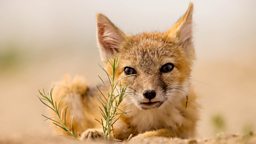Pockets of hope for the swift fox of the Great Plains
By Tessa Worgan, Producer and Director for Dogs in the Wild
the most threatened terrestrial ecosystem in the world
Looking out over the prairies of North America, you would be forgiven for thinking that this is a barren and lifeless land. But this habitat, the most threatened terrestrial ecosystem in the world, is home to a charismatic little canid, the swift fox. This tiny fox must survive the sweltering temperatures, freezing nights, and patrolling predators of the grasslands. Historically they lived across much of the Great Plains, but after years of non-target poisoning and habitat loss the species range has become fragmented. And these are not the only prairie animals to have suffered great losses. Plains bison, and the highly endangered black-footed ferret were brought to the brink of extinction, and prairie dogs have seen massive decreases in numbers. But there are pockets of hope in these vast grasslands.

The swift fox holds deep cultural significance to the Nakoda (Assiniboine) and Anaiiih (Gros Ventre) Tribes of Fort Belknap Indian Community, Montana, and for the past three years they have been working with partner organisations, across several states, to bring the swift fox back to their lands, and establish a self-sustaining fox population after an absence of over fifty years. In the process reconnecting a fox population to the North of the reservation, to another one further South.
The swift fox holds deep cultural significance to the Nakoda
Each year small groups of foxes are moved from thriving populations in Wyoming and Colorado to the 1,000 square miles (2,600 square kilometres) reservation in Montana. After the foxes arrive, they are fitted with 57-gram GPS collars, which are only 3% of the foxes' body weight. These collars gradually degrade and fall off after about a year of use, but they help researchers determine where the foxes settle after their relocation. The foxes are placed in temporary holding pens, where they can acclimatise to their new home whilst being protected from predators. Then the foxes are released with a simple, but hugely symbolic, opening of the wire fence that surrounds the pen. The release of the foxes is always met with much excitement in the community, as their lands welcome back these small canids, joining the bison and black-footed ferret that, thanks to the Tribes efforts, have already been reintroduced to the Reservation.

twenty kits have been born in recent years
To date a total of one hundred and three foxes have been relocated to Fort Belknap Reservation. Some have travelled long distances after release. On one occasion, a GPS collar recorded an individual travelling over 200 miles away. However, most have remained in the reservation and the surrounding areas. At least four dens have been found on the reserve, and twenty kits have been born in recent years. The breeding fox pairs are a sign of the success of this program and help extend the range of this ecologically and culturally important animal.



